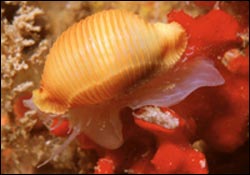DNA barcodes put to the test

The charismatic cowrie. (Photo: Meyer and Paulay)
With species around the world disappearing faster than biologists can identify them, many scientists pinned their hopes on DNA barcoding, a recently proposed strategy that treats a short fragment of DNA as a sort of universal product code to identify species. But this approach generated controversy from the start, with skeptics bristling at the notion that a single gene fragment could perform such a tall task. In a new study published in PLoS Biology, Christopher Meyer and Gustav Paulay revisit the issue with a diverse, extensively studied snail group, the ubiquitous, tropical marine cowries whose shell can command over $30,000. Meyer and Paulay found that while the barcode worked well for identifying specimens in highly characterized groups, it was much more error prone when used to discover novel species.
For most animals, the DNA barcode consists of just over 600 base pairs of a mitochondrial gene called cytochrome oxidase subunit I (COI). After ten years of collecting and sequencing cowries from around the world, Meyer and Paulay assembled a database of over 2,000 cowrie COI sequences from 218 species. To capture the full range of within-species variation and geographic differences in population structure, they included sequences from multiple individuals and geographic extremes. Meyer and Paulay tested barcode performance in species identification and discovery against traditional morphology-based species lists and against an integrated taxonomic approach that determines “evolutionary significant units” (ESUs) based on morphology and sequence data. ESUs are what’s called reciprocally monophyletic–two ESUs each have a unique ancestor, and, therefore, a unique genetic signature.
Their comprehensive analysis demonstrates that relying solely on DNA barcodes masks fine-tuned species boundaries not captured in DNA sequences. The barcode performs best in identifying individuals against a well-annotated sequence database–as demonstrated here with ESUs–and the authors argue that the barcoding movement is well-equipped to help in this effort. But barcoding methods for discovering new species need refinement, they argue, and should be developed in collaboration with taxonomists, systematists, and ecologists into a comprehensive taxonomic framework. Once databases are fully annotated with taxonomically evaluated sequences, error rates should go down. With just 1.7 million species described and some 10 million to go, there’s a lot of work to be done.
Media Contact
More Information:
http://www.plosbiology.orgAll latest news from the category: Life Sciences and Chemistry
Articles and reports from the Life Sciences and chemistry area deal with applied and basic research into modern biology, chemistry and human medicine.
Valuable information can be found on a range of life sciences fields including bacteriology, biochemistry, bionics, bioinformatics, biophysics, biotechnology, genetics, geobotany, human biology, marine biology, microbiology, molecular biology, cellular biology, zoology, bioinorganic chemistry, microchemistry and environmental chemistry.
Newest articles

A universal framework for spatial biology
SpatialData is a freely accessible tool to unify and integrate data from different omics technologies accounting for spatial information, which can provide holistic insights into health and disease. Biological processes…

How complex biological processes arise
A $20 million grant from the U.S. National Science Foundation (NSF) will support the establishment and operation of the National Synthesis Center for Emergence in the Molecular and Cellular Sciences (NCEMS) at…

Airborne single-photon lidar system achieves high-resolution 3D imaging
Compact, low-power system opens doors for photon-efficient drone and satellite-based environmental monitoring and mapping. Researchers have developed a compact and lightweight single-photon airborne lidar system that can acquire high-resolution 3D…





















